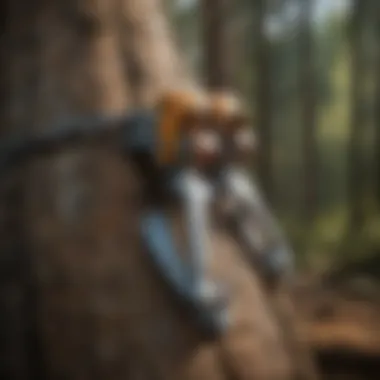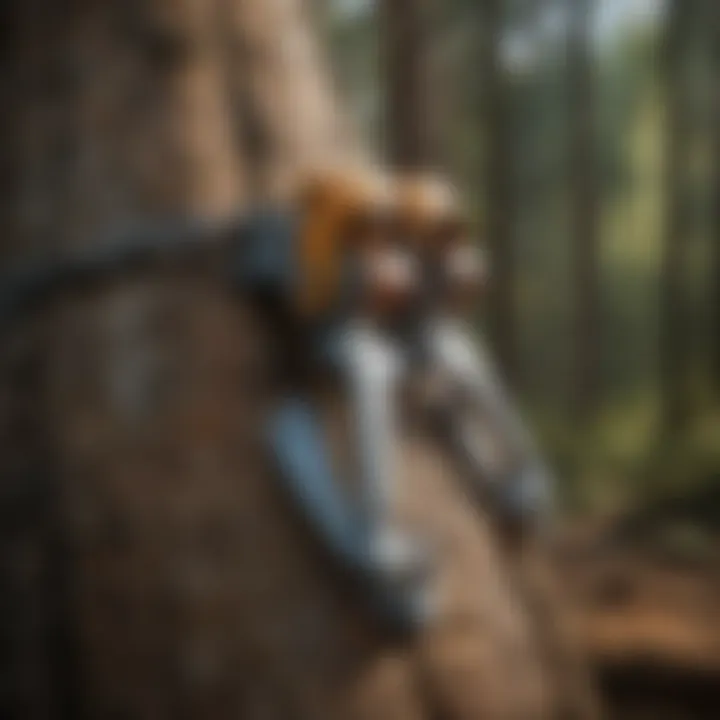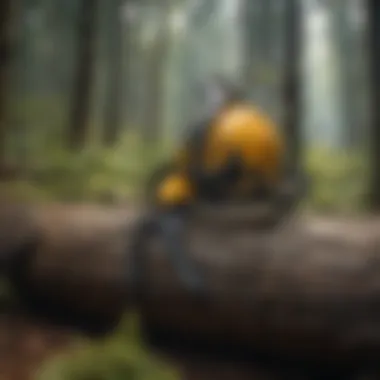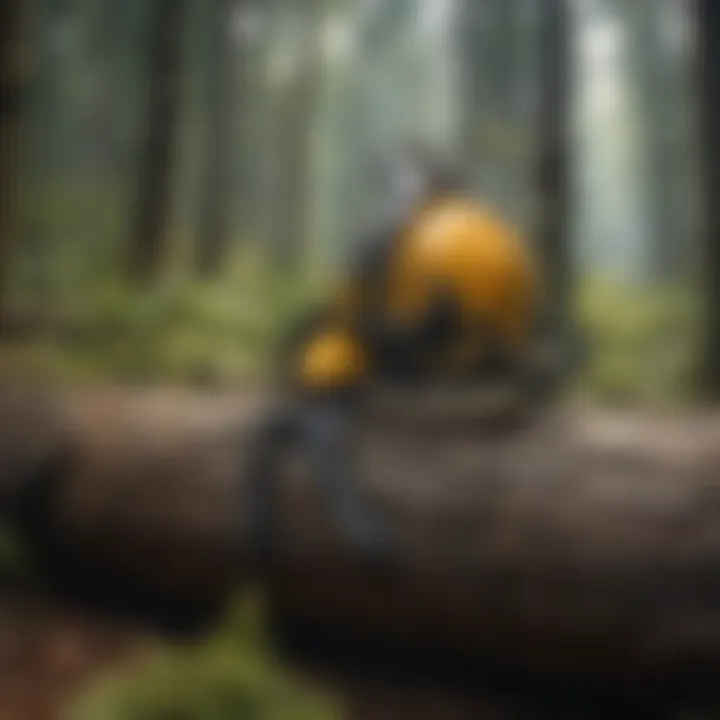The Importance of Weaver Climbing Spurs in Forestry


Intro
Forestry management isn't just about chopping wood and clearing space; it’s a delicate dance with nature that requires knowledge and respect. Central to this dance are tools that, while seemingly simple, play a pivotal role in maintaining the health and vitality of woodland ecosystems. Among these tools are weaver climbing spurs, which enable forestry professionals to ascend trees safely and efficiently. This article will explore their significance in forestry practices, from improving tree health to ensuring worker safety in a discipline that demands both precision and care.
Understanding Woodland Ecosystems
Importance of Biodiversity in Forests
Biodiversity is often regarded as the backbone of any forest ecosystem. A rich variety of plant and animal species contributes to the stability of the ecosystem and its ability to withstand environmental changes. When set against the backdrop of climate change and habitat loss, protecting biodiversity becomes paramount not just for the woodland but for the larger environment.
The weaver climbing spurs can assist in various ecological practices. For instance, they allow foresters to reach higher branches for tasks such as disease inspection or to collect data on species that are crucial for ecosystem assessments.
Role of Forests in Climate Regulation
Forests act as carbon sinks, absorbing CO2 from the atmosphere and, thus, play a crucial role in combating climate change. By promoting responsible forest management practices, we can enhance the capacity of woods to sequester carbon and help maintain air quality. Utilizing climbing spurs makes it feasible to conduct top-down assessments of tree health, ensuring that forests continue their role in climate regulation.
Sustainable Forestry Practices
Principles of Sustainable Forestry
Sustainable forestry hinges on practices that maintain the forest’s biodiversity, productivity, and ecological processes while ensuring that the needs of current and future generations are met. Climbing spurs are integral to these practices as they help in evaluating forest health and enable foresters to plan accordingly.
Some basic principles include:
- Minimizing disturbance: Careful climbing practices help limit damage to trees.
- Regular assessment: Using climbing equipment allows for consistent monitoring of tree vitality.
- Mixed-species planting: Climbing aids can facilitate working in diverse habitats.
Case Studies of Successful Implementations
In regions like the Pacific Northwest, foresters have utilized weaver climbing spurs in sustainable practices that have shown tangible results. For example, on the Olympic Peninsula, climbers were employed to assess old-growth trees for health indicators. This initiative not only improved management strategies but also increased public awareness of sustainable practices. Such case studies reinforce the practical benefits of climbing spurs in promoting both fiscal and ecological resilience.
Woodland Stewardship Techniques
Forest Management Plans
A well-structured forest management plan is the cornerstone of effective woodland stewardship. These plans must consider various factors, including the ecological health of the forest, the economic needs of the local community, and the potential impacts of climate change. Climbing spurs play a significant role in gathering the necessary field data to inform these plans.
Conservation Strategies
Conservation efforts must adapt to current environmental challenges. Using climbing spurs, foresters can access hard-to-reach areas to evaluate tree health, monitor wildlife habitats, and implement conservation measures where they are most needed. This hands-on approach ensures that strategies are grounded in solid observational data.
"Effective forestry is about nurturing relationships with nature; that’s where tools like weaver climbing spurs become indispensable."
By understanding the various dimensions of woodland ecosystems, promoting sustainable practices, and employing effective stewardship techniques, we can better appreciate and protect our forests. This detailed approach serves not just the trees but the entire community that relies on them.
This narrative sets the stage for a deeper investigation into how weaver climbing spurs serve as more than just tools; they are instrumental in a broader dialogue about ecological stewardship and sustainable forestry.
Prelims to Weaver Climbing Spurs
Understanding the role of Weaver climbing spurs is fundamental in forestry practices, especially when focusing on tree maintenance and stewardship. These tools, often seen as a mere accessory for arborists, carry significant implications for both operational effectiveness and ecological preservation. As urbanization encroaches on natural habitats, the importance of effective forestry techniques cannot be understated.
The integration of climbing spurs allows forestry professionals to conduct crucial tasks such as tree trimming, health assessments, and ecological management with greater efficiency. Climbing spurs enhance access to tree crowns, enabling more in-depth inspections and interventions that contribute to the overall health of forest ecosystems. For instance, a tree that suffers from disease can be treated more effectively when practitioners can reach its upper sections without disturbance.
Moreover, the use of these spurs is intertwined with discussions about safety protocols. Proper training and equipment handling can mitigate the risks associated with working at heights, ensuring that professionals can focus on their task instead of worrying about their safety. In doing so, Weaver climbing spurs are more than just practical tools; they symbolize a commitment to sustainable forestry practices and the responsible management of natural resources.
In addition to utility and safety, the historical context of spurs reveals much about the evolution of forestry techniques over the years. Understanding this lineage not only highlights advancements in tool design but also reflects changing attitudes toward forest conservation and ecosystem management. This narrative sets the stage for articulating how we can adapt current practices to cater to the pressing environmental challenges we face today.
"The tools of today are the foundations upon which we build tomorrow's forests."
This introduction lays out not only the significance of Weaver climbing spurs but also invites readers to delve deeper into the intricate components and applications of these tools within forestry. As we proceed through the article, we will explore their definition, historical relevance, and the technical details that underline their usage in fostering healthy woodland ecosystems.
Understanding the Components of Climbing Spurs
The importance of understanding the components of climbing spurs cannot be overstated for those engaged in forestry practices. Climbing spurs are not merely tools; they are intricately designed apparatus that enhance both the safety and efficiency of tree climbers. Each part plays a vital role, contributing to both the operational functionality of the spurs and the climbers’ overall safety.
Design Features
Material Properties
When one looks at material properties, the durability and weight of the materials used in climbing spurs are key considerations. Generally, climbing spurs are crafted from aluminum or stainless steel. Aluminum is appreciated for being lightweight while still providing the strength needed to support a climber securely. Stainless steel, on the other hand, offers robust resistance to corrosion, which is beneficial for prolonged exposure to the elements.
The key characteristic to underline here is wear resistance. Climbers often face challenging environments, and spurs made from these materials can withstand significant abuse. This quality makes aluminum and stainless steel popular choices in the industry. A unique feature of these materials is that they can be treated to enhance their grip on tree bark, allowing for greater stability while climbing.
However, one must also consider the downsides of certain materials. For instance, while lightweight, aluminum can bend under extreme pressure, which could be a severe risk factor during climbs. Thus, it’s crucial for climbers to choose equipment that balances weight and strength appropriately.


Ergonomic Considerations
Ergonomics in climbing spurs concerns how they fit on the climbers’ feet and what comfort they offer during extended use. The design often incorporates padding and adjustable straps, which help in customizing the fit for various foot shapes. This flexibility contributes significantly to a climber’s ability to remain agile and balanced during their ascent.
A vital characteristic of ergonomic design is that it minimizes fatigue. Well-designed climbing spurs reduce pressure points on the foot, allowing climbers to focus on their tasks rather than being distracted by discomfort. Some products even feature shock-absorbing materials, which help in absorbing impact when climbers move between footholds.
While ergonomic considerations add to overall usability, they can sometimes lead to trade-offs with sturdiness. For instance, the padding may wear out through time, necessitating more frequent replacements. Thus, ensuring that the spurs maintain a balance between comfort and durability is essential for climbers.
Functional Parts
Spikes
The spikes on climbing spurs are not just sharp tools; they are pivotal for ensuring secure attachment to the tree. They are usually shaped to penetrate the bark effectively, allowing climbers to gain a solid foothold. Each spike’s projection length can vary, and this variability can impact both the ease of climbing and the risk of damaging the tree.
The standout feature here is the design of the spikes. They often come in various shapes, such as tapered or dual-pointed, each serving different climbing styles or tree species. The choice of spike design can significantly influence climbing efficiency.
However, one downside can be that longer spikes might compromise a tree's health, particularly if used on species that are sensitive to bark damage. Hence, climbers must be vigilant about their climbing techniques to avoid any harm to the trees they are working on.
Belt Systems
Belt systems are critical components that provide climbers with the necessary support and harnessing when climbing. Efficient belt systems come with multiple adjustment options. This allows for better weight distribution, which is vital when one is scaling tall trees for maintenance or health assessments. A well-designed belt system assists in distributing the climber’s weight evenly, reducing the risk of straining any particular muscle group.
One prominent feature of these systems is the inclusion of quick-release mechanisms, which enhance safety and ease of use in emergencies. Being able to detach quickly can be a game-changer in precarious situations.
Applications of Weaver Climbing Spurs in Forestry
The applications of weaver climbing spurs are indispensable in the forestry sector. These tools serve not only to facilitate access to tree canopies but also enhance the effectiveness of various forestry practices. With an increasing demand for sustainable forest management, understanding how to properly utilize climbing spurs becomes not just beneficial but crucial. By exploring the ways in which these spurs aid in tree maintenance and ecological management, we unveil the multi-faceted roles they play in the stewardship of woodland ecosystems.
Tree Maintenance Strategies
Crown Care
Crown care involves the strategic management of a tree's uppermost section. This practice is essential in ensuring trees remain healthy and productive. One key aspect of crown care is the ability to prune effectively, which is far simpler when using climbing spurs. These spurs provide climbers with the necessary stability and reach, allowing them to perform tasks such as removing dead branches or reducing canopy weight. This practice not only enhances the aesthetic value of trees but also supports their overall health.
A particular advantage of using climbing spurs in crown care is the precision they afford; climbers can target specific branches while minimizing disruption to the surrounding ecosystem.
Health Assessments
Health assessments are pivotal in diagnosing tree diseases and other issues. By utilizing climbing spurs, forestry professionals can perform thorough examinations from a vantage point that ground-level assessments simply can't provide. These elevated evaluations allow for a better understanding of a tree’s overall health, spotting signs of stress or disease that might otherwise go unnoticed.
The defining feature of health assessments is perhaps the access they provide to the upper branches and leaves, critical areas for identifying problems. Moreover, climbing spurs can make this process much safer, significantly reducing the time spent on potentially hazardous ground-level inspections. However, there is the potential downside; if climbing spurs are not used properly, they can sometimes exacerbate the stress on the trees.
Ecological Management
Biodiversity Preservation
Biodiversity preservation is vital for maintaining the ecological balance within forests. The use of climbing spurs in this context allows for targeted inspections of specific species of trees and other flora. By climbing into the canopy, forestry professionals can monitor biodiversity metrics more effectively, ensuring that no species is overlooked. The ability to reach various strata of the forest is a key characteristic of this practice.
Furthermore, this method proves beneficial, as it often results in the detection of invasive species before they can establish themselves. Climbing spurs might bring about disturbance to some extent, but the potential to contribute to the long-term health of a forest ecosystem can outweigh those risks.
Habitat Restoration
Habitat restoration is another crucial application of climbing spurs. They allow ecologists and forestry specialists to access tree canopies, enabling them to evaluate and amend damage caused by pests or adverse weather conditions. A rippling effect is created when spurs are employed effectively, as they facilitate the reintroduction of native species and help improve habitat conditions.
The unique feature of habitat restoration with climbing spurs lies in their flexibility; they can be used in both urban and rural forestry initiatives. However, one must be cautious that excessive use can lead to soil compaction and other unintended consequences. Balancing spurs' utility with awareness of environmental impact is necessary for successful restoration efforts.
“Using climbing spurs not only enhances accessibility but amplifies our ability to care for and understand forest health and biodiversity.”
In summary, weaver climbing spurs reveal their significance through various applications in forestry, from improving crown care practices to reinforcing efforts in biodiversity preservation and habitat restoration. As we refine our strategies and utilize advanced tools, the relationship between climbers and the health of our forests will strengthen, leading to more sustainable management practices.
Safety Protocols in Using Climbing Spurs
The use of climbing spurs in forestry is not without risks. Safety protocols are indispensable to ensure the well-being of climbers while they tackle trees and other obstacles. The intricate balance between effective tool usage and safety measures highlights the importance of implementing comprehensive protocols. From risk assessments to personal protective gear, these protocols serve to protect individuals in one of the most hazardous environments imaginable—a forest.
Risk Assessment
Identifying Hazards
Identifying hazards is a critical step in creating a safe working environment for climbers. This process involves recognizing the potential dangers that may be present during tree climbing activities. A fundamental aspect of this practice is to evaluate the environment closely. Sharp branches, unstable footholds, and even the tree species itself can pose significant risks. Not only does identifying hazards help climbers avoid accidents, but it also contributes to greater situational awareness, a key characteristic of efficient tree management.
One unique feature of identifying hazards is its proactive nature. Rather than waiting for incidents to occur, climbers can anticipate challenges and adjust their approach accordingly. This foresight can lead to significant benefits, such as reduced injury rates and enhanced overall productivity.
Mitigation Strategies
Following the identification of hazards, developing mitigation strategies becomes crucial. These are the specific actions or procedures put in place to minimize risks associated with climbing spurs. A central characteristic of effective mitigation strategies is their adaptability; they can be tailored to specific situations and varied environments encountered in forestry.
Having a set of procedures allows climbers to respond systematically to potential accidents or injuries. Unique considerations, such as weather conditions, tree condition, and climber experience, inform these strategies. These factors create advantages, such as enhancing team communication and reinforcing the importance of safety without compromising efficiency.


Best Practices
Personal Protective Equipment (PPE)
The incorporation of personal protective equipment is a significant facet of climber safety. PPE serves as the first line of defense against potential injuries that may arise from falling branches or spikes. Key characteristics of PPE include helmets, harnesses, and protective gloves, which all work collaboratively to protect climbers.
The benefit of utilizing PPE is clear—it helps mitigate the severity of injuries if accidents occur. A unique aspect of PPE is its role in building confidence among climbers. When one knows they are well-equipped to face risks, it naturally leads to more agile and less cautious movements. However, it is vital to ensure gear fits correctly and is regularly maintained, as defective equipment can lead to unforeseen accidents.
Emergency Preparedness
Finally, emergency preparedness must not be overlooked in the realm of climbing safety. This aspect involves having comprehensive plans in place to respond to emergencies, whether they involve falls, equipment failure, or sudden health issues. A key characteristic of robust emergency preparedness is the establishment of clear lines of communication among team members.
An advantage of focusing on emergency preparedness is that it instills a culture of safety among all climbers. When individuals recognize that their team has structured responses to emergencies, it allows them to focus better on their specific tasks. However, the challenge lies in regularly practicing these emergency protocols so that they become second nature.
"An ounce of prevention is worth a pound of cure." This adage rings especially true in the forestry setting, where the unexpected can quickly turn hazardous.
Training and Skill Development for Climbers
Training and skill development are cornerstones of effective forestry practices, particularly when using tools like Weaver climbing spurs. Those involved in forestry, whether they're professionals or volunteers, need to understand the complexities of climbing, along with the potential dangers involved. Gaining and honing the right skills can not only enhance the efficiency of climbing tasks but also ensure the safety of everyone involved. Moreover, proficient climbers can perform their duties with a heightened awareness of environmental impact, making their training integral to sustainable forestry.
Climbing Techniques
Basic Skills
When we talk about basic skills in climbing, we refer to the fundamental techniques that every climber must grasp before they venture higher into the treetops. These skills include proper harness fitting, basic knot tying, and mastering the art of balancing on spurs. The significant characteristic of basic skills is their focus on creating a strong foundation. Novice climbers gain confidence through mastering these skills, ensuring they can safely and effectively use their climbing equipment, including the Weaver climbing spurs.
The uniqueness of basic skills lies in their simplicity. They serve as the entry point into the more complex world of climbing. While these skills may seem straightforward, they are essential for anyone looking to ensure the climbing experience is productive and secure. One advantage is that once mastered, these skills can enable climbers to transition into more advanced techniques without feeling overwhelmed or unprepared.
Advanced Maneuvers
Advanced maneuvers take climbing to the next level, incorporating techniques like dynamic repositioning, managing multiple ropes, and utilizing other advanced climbing gear alongside the spurs. These maneuvers are crucial for professionals who need to navigate complex tree structures or deal with emergency situations in a forest environment. The importance of advanced maneuvers is that they provide the climber with greater versatility and control when working on the job.
A defining characteristic of advanced maneuvers is their focus on precision and timing. Climbers who are proficient in these techniques often find themselves working more efficiently and effectively, which is beneficial in high-stakes forestry operations. On the other hand, the learning curve can be steep, and it may require additional resources and time to become proficient in these skills. However, the advantages clearly outweigh the downsides, as advanced maneuvers equip climbers to handle a variety of challenges in the field.
Educational Programs
Certification Courses
Certification courses provide formalized training that helps climbers develop their skills in an organized manner. These programs often blend theoretical knowledge with practical experience, making them a popular choice for serious climbers in the forestry industry. A key feature of certification courses is the ability to earn credentials that are respected in the field. This kind of recognition elevates a climber's profile and can open doors to greater job opportunities and responsibilities.
The unique aspect of certification courses is that they usually have a set curriculum, giving students exposure to all essential climbing skills. One advantage is that participants receive mentorship from seasoned professionals, which can accelerate their learning process. However, they can be time-consuming and sometimes costly, which may pose a barrier for some learners.
Workshops and Field Training
Workshops and field training serve as excellent supplements to formal education. They often focus on practical applications, giving climbers a chance to practice their skills in a real-world setting. The key characteristic of these sessions is their hands-on approach, which can enhance the retention of crucial climbing techniques. This real-life experience is invaluable, as forestry workers often face unique challenges that don’t always come up in classroom settings.
The unique feature of workshops is the opportunity for immediate feedback from instructors, allowing climbers to adjust their techniques on-the-spot. One significant advantage is increased camaraderie among participants, fostering a sense of community and shared learning. On the downside, the informal nature of workshops might lead to variability in quality, as not all sessions are created equal.
"Skill development is not just about learning; it's about transformation into a safer and smarter climber."
Engaging with these various elements allows for both effective climbing and a responsible approach to environmental stewardship.
Impact of Weaver Climbing Spurs on Forest Ecosystems
Weaver climbing spurs serve as crucial tools within the forestry sector, enabling professionals to access canopy layers and conduct necessary maintenance practices. Their impact on forest ecosystems extends beyond just individual climbing experiences; it encompasses a range of ecological considerations that play an important role in woodland stewardship and sustainability. By using climbing spurs responsibly, climbers can bolster their operations without disregarding the delicate balance of the ecosystem they are working within.
Environmental Considerations
Footprint Analysis
Footprint analysis relates to the environmental impact caused by the use of climbing spurs. This analysis highlights how these tools can disturb the surrounding ecosystem during climbing activities. Key characteristics of this analysis include identifying areas that bear the brunt of the climber's weight, as well as the potential for soil compaction and vegetation damage. This consideration is beneficial because it promotes more mindful use of equipment, ensuring that climbers are aware of how their movements affect the forest floor and surrounding plant life.
Unique to footprint analysis is its ability to cultivate a sense of responsibility among climbers. By understanding the specific areas affected, climbers can develop strategies that preserve rather than harm, leading to a more sustainable approach to climbing practices. One challenge, however, can be ensuring that climbers consistently apply this knowledge in varying terrains and forest types.
Minimizing Disturbance
Minimizing disturbance aims to reduce the impact climbers have on the forest environment. A key characteristic of this approach is implementing techniques that allow for efficient tree access while ensuring the canopy and forest floor experience as little disruption as possible. The strategies that fall under this banner are integral to maintaining a healthy woodland ecosystem.
A unique aspect of minimizing disturbance is its emphasis on route planning. By carefully selecting climbing paths and minimizing footprints, climbers can protect sensitive vegetation and wildlife habitats from degradation. This proactively addresses potential negative effects, making it an appealing strategy for those concerned with conservation. Yet, it demands a high degree of planning and awareness from climbers, which can be burdensome for those who may lack experience or knowledge of specific areas.
Conservation Implications
Assessing Damage
Assessing damage refers to the process by which climbers evaluate the effect of their activities on tree health and overall forest vitality. This aspect is vital as it helps in understanding the implications of spurs on trees and the surrounding landscape. A key feature of assessing damage involves identifying signs of stress or deterioration, which can include bark injuries or loss of canopy foliage.


This practice promotes accountability among climbers, reinforcing the need for responsible equipment use. However, it means climbers must invest time and energy into thorough inspections post-climb, which might not always be feasible in large areas or tight schedules. The upside is that it fosters a deeper connection with the environment as climbers learn to recognize the intricate signs of plant health.
Long-term Monitoring
Long-term monitoring is the ongoing process of tracking forest health over time, particularly in areas frequently accessed by climbers. This is essential, as it allows for the detection of patterns or changes that might arise due to repetitive climbing. A key aspect of long-term monitoring is the establishment of baseline data, which serves as a comparison point for evaluating future ecological conditions.
This approach is beneficial because it enables forestry professionals to adopt adaptive management strategies tailored to specific environmental changes. Moreover, setting up monitoring programs can offer insights into the broader effects of forestry practices on ecosystems. However, maintaining long-term monitoring requires dedication for consistent data collection and analysis, something that can necessitate resources and commitment from involved parties.
Innovations in Climbing Equipment
Understanding the role of innovations in climbing equipment is crucial for anyone involved in forestry practices. This sector requires tools that not only ensure efficiency but also prioritize safety and ecological preservation. Weaver climbing spurs, in particular, have evolved significantly with technological advancements that enhance their functionality and usability. These innovations are not mere bells and whistles; they provide real benefits that resonate throughout woodland management.
Technological Advances
Smart Spurs
Smart spurs represent a remarkable leap in climbing technology. These devices integrate sensors and data collection tools, allowing climbers to monitor various parameters in real-time. One key characteristic of smart spurs is their ability to assess both user positioning and the condition of the tree being climbed.
Such capability makes them a popular choice among forestry professionals. Their usage can lead to a reduction in accidents and better resource management by ensuring that climbers gather data on tree health and growth patterns while they work.
The unique feature of smart spurs is their connectivity to mobile apps, making it easier for climbers to share findings instantly. While the benefits of these innovations are substantial, they also include disadvantages such as the potential for technological failure. Like any gadget, smart spurs can malfunction, and reliance on them could lead to complacency in traditional skills.
Material Enhancements
Material enhancements have revolutionized the production of climbing spurs. The shift towards lightweight alloys and composite materials has resulted in gear that is not only easier to wear for lengthy periods but also durable against the elements. This characteristic is essential for climbers who are often exposed to varying weather conditions.
In this article, material enhancements stand out as a beneficial choice because they improve overall performance and reduce fatigue. Climbers can ascend trees with greater agility, making the work less strenuous.
A unique feature of these modern materials is their ability to endure wear and tear much better than traditional options. This longevity means less frequent replacements, which could be a cost-saving measure in the long run. However, the downside is the higher upfront cost, which some may perceive as a barrier to entry for new climbers.
Future Trends
As we look ahead, the landscape of climbing equipment continues to evolve, presenting future trends that could further shape forestry practices. Innovations in design and functionality are paving the way for better tools.
Sustainable Designs
Sustainable designs are gaining traction within climbing equipment innovation. They focus on using renewable materials and minimizing carbon footprints during manufacturing. The key characteristic of sustainable designs is their reduced environmental impact, making them an appealing option for eco-conscious forestry professionals.
For this article, focusing on sustainable designs signifies a commitment to preserving the very ecosystems that climbers work within. Unique features include the use of biodegradable materials and energy-efficient production processes. While they promote a positive image, challenges, such as potential performance trade-offs, keep the debate alive.
Adaptations for Urban Forestry
Lastly, adaptations for urban forestry are an emerging trend that addresses the unique challenges faced in urban settings. These tools are tailored with features that consider factors like space restrictions and the specific types of trees found in cities. A significant aspect is their compact design, allowing climbers to navigate tight spots with ease.
These adaptations are beneficial because they expand the usability of climbing spurs in environments that require special consideration. However, the emphasis on urban contexts may limit their application in more rural forestry operations, presenting a trade-off that needs to be acknowledged.
Case Studies of Weaver Climbing Spurs in Action
Case studies serve as invaluable learning tools, revealing the real-world applications and outcomes of employing Weaver climbing spurs in forestry practices. These narratives not only showcase effective techniques but also highlight the challenges forestry professionals navigate in their fieldwork. By examining specific instances of spurs in use, we can glean significant insights into their utility and effectiveness. Here we dive into two pivotal areas: success stories from national parks and impactful community projects.
Success Stories
National Parks
Within the context of national parks, the application of Weaver climbing spurs is prominent. These protected areas often require meticulous attention to ensure their ecological health and visitor safety. When climbers employ climbing spurs to maintain trees within these parks, they can tackle issues such as diseased branches or safety hazards caused by fallen trees.
One of the most notable examples comes from Yellowstone National Park, where climbers utilize these spurs to reach elevated canopies for inspection and management. This proactive approach helps safeguard both the park's biodiversity and the people who visit. A key characteristic of national parks is their vastness and richness in biodiversity. By using climbing spurs, the park services can address tree health and ensure tree species are thriving and not overrun by diseases. This not only preserves the park's natural beauty but also contributes to the overall health of the ecosystem.
However, while there are benefits, there are also potential downsides. The use of climbing spurs can lead to localized damage if not applied judiciously, making it essential for park personnel to be well-trained and aware of their surroundings.
Community Projects
Community projects often illustrate the grassroots application of Weaver climbing spurs. These initiatives frequently aim to restore urban woodlands or enhance neighborhood green spaces, often relying on volunteer climbers who need basic training before engaging in tree maintenance.
For instance, a community-driven tree care initiative in New Orleans harnessed the capabilities of climbing spurs to help maintain an array of native species in urban settings. A critical aspect of these community projects is the opportunity they provide for local volunteers to engage hands-on with forestry work, fostering a sense of stewardship toward their environment. The benefits of such projects extend beyond physical maintenance; they also develop community involvement and awareness regarding tree health.
Of course, there are challenges. Engaging volunteers often means varying skill levels, which necessitates clear instructions and safety protocols. An inadequate understanding of the equipment can lead to accidents or ineffective practices that fail to address the underlying issues. Therefore, while community projects can leverage the advantages of climbing spurs, they must also instill proper training and guidance for success.
Lessons Learned
Challenges Faced
Each case study reveals certain challenges that arise in forestry practices involving climbing spurs. Whether in national parks or community projects, climbers often encounter issues related to safety and the technical skill required for effective tree management. For national park climbers, encountering unpredictable weather conditions can pose a significant risk when working at heights. In community projects, the volunteers’ varying levels of experience with climbing equipment can lead to a learning curve that may deter some individuals from participating.
Best Practices Derived
Through years of practical experience, certain best practices have emerged that enhance the effectiveness of climbing spurs in forestry. Training programs that focus on both safety protocols and ecological understanding lead to better performance and greater tree health outcomes. Providing climbers with not only the technical skills needed to use climbing spurs effectively but also an awareness of the ecological context helps them make informed decisions during their work. Essential training includes:
- Clear communication of goals: Ensure that every climber understands the project's objectives.
- Focus on safety: Regular drills and safety checks can minimize accidents.
- Emphasis on environmental stewardship: Educating climbers about the ecological impacts of their work encourages a long-term appreciation for forest preservation.
These lessons underscore that both case studies and practical experiences are fundamental in refining methodology and enhancing forestry practices. The blend of successes and challenges forms a narrative that not only informs but also inspires improved stewardship efforts in forestry.







